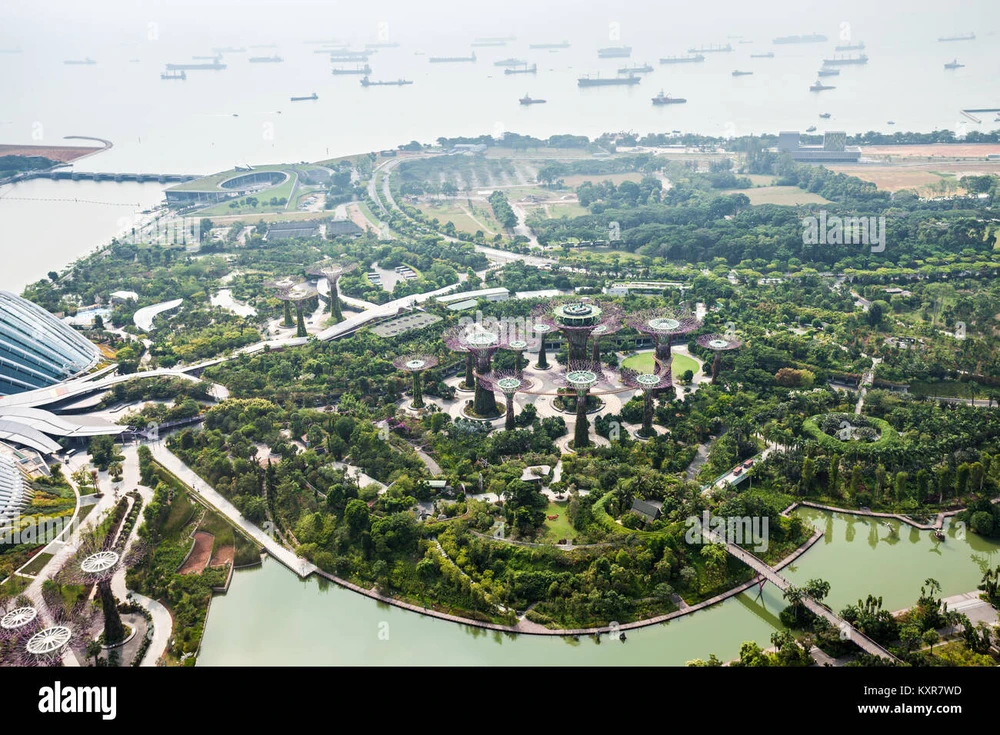
However, Singapore is known the world over as the greenest country. According to a recent study by the Massachusetts Institute of Technology (MIT) and the World Economic Forum (WEF), this small island nation has topped the list of cities for the greenest urban cover in the world.
Singapore has a green area per capita of 39 square meters, along with Seoul in South Korea at 41 square meters per person, Berlin in Germany at 50 square meters per person, Moscow in Russia at 44 square meters per person, and Paris in France at 25 square meters per person. Those who have visited Singapore are left impressed by the green cover that permeates everywhere from Changi Airport to the streets, government offices, parks, and houses. Within such a small area, it is surprising how Singapore finds land to plant trees and shrubs.
Strict regulations for projects
In 1965, when Singapore separated from Malaysia to become an independent country, it was just a very poor and impoverished island covering around 500 square kilometers of land. Over the next 50 years, Singapore reclaimed land from the sea to increase more livable space. Mr. Lee Kuan Yew was determined that Singapore would not develop industry and agriculture, but only offer services, in which high-quality shipping, tourism, healthcare, education, and entertainment services were to be the main focus.
One of the tasks set out as a strategy was to create a green, clean, beautiful, and attractive Singapore. Mr. Lee Kuan Yew expressed clearly that no one goes to a dirty, hot, ugly country to visit, study, or heal. He had a firm belief that when Singapore became green, clean, and beautiful, it would enhance the country's competitive edge. This trail of thought has helped Singapore to become a world-class developed nation. For his ideas and plans to be implemented, Mr. Lee Kuan Yew introduced a series of very strategic plans.
First of all, he assigned the world-famous architect Luu Thai Co to build an integrated plan that would never go out of date and in which Singapore would see its development as a garden city. The architect followed the instructions and to date Singapore has not been concretized and the green cover across the island is very multi-layered, with the lowest level being grass, then shrubs, then low-rise trees, then moving to middle and upper floors of high-rise structures. Therefore, the greening rate of high-rise spaces viewed from above is more than 75%, and the greening rate on the ground is also around 50%.
Although the land area in Singapore is more precious than diamonds, the country has reserved land for 350 parks and botanical gardens. Among these are very large parks located right in the center of the city area, such as the Singapore Botanic Garden covering 630,000 square meters, Gardens by the Bay covering 940,000 square meters, and Sentosa green island which covers 5,000,000 square meters. In neighborhoods without trees, the government has restructured and demolished entire neighborhood, and compressed the living space to preserve land for green parks. New urban areas and apartment projects that do not have a satisfactory percentage of trees are not given a construction license.
Violations included in law
At the very beginning of the transformation of Singapore, Mr. Lee Kuan Yew realized that the green revolution would only succeed with the absolute participation of the entire population. Mr. Lee Kuan Yew launched the National Tree Planting Day to be held on the first Sunday of November each year. This day has now become a national tradition and a celebrated festival for the people of Singapore. Mr. Lee Kuan Yew is honored and referred to affectionately as the Chief Gardener of Singapore by the people. Until his death, Mr. Lee Kuan Yew did not miss a single day of this event for planting a tree.
He inspired all Singaporeans to plant trees, making them feel proud of their responsibility for living in a large green space. Singaporeans are very proud of their green country and are excited in participating in the greening of each apartment, street corner, and community area. They have created street gardens, wall gardens, roof gardens, balcony gardens, and terrace gardens, and have enthusiastically created sublime green areas across the entire country.
In order for the green strategy to remain long-term and sustainable, the Singapore government has set up management agencies specializing in trees and green cover. The National Parks Board is the unified management body for the national green spaces in addition to large social organizations connected to the State, which have joined hands to develop a green nation. Singapore has built a Garden City Fund, a Green Volunteer Program, and many community groups, schools, businesses, and companies are closely linked with the ecological centers and green areas under the State.
Singapore has the world's best institutes, universities, and research centers that all advocate a green culture. Here, varieties of plants suitable for Singapore's weather and climate are grown, ensuring that they can withstand storms, use less water, do not damage construction, and are non-toxic. According to the National Parks Authority of Singapore, there are currently more than 2,000 different species in the country all of which have their genetic resources stored with more than 2,000,000 trees, covering more than 70% of area across the country.
Singapore also has several strict regulations that are attached to the laws of the land, such as the Construction Law, the Residence Law, and the Civil Law which encourages and penalizes individuals and organizations that violate the green spaces. Under Singapore's Parks and Trees Act, citizens cannot cut down any tree growing on land that is planned for tree conservation, unless authorized by the National Parks Council (NParks). Violators are made to pay a fine of USD 2,000 to NParks, with some fines even going up to USD 50,000 as stipulated by a judge in a court. Because of these strict regulations, tree cutting is almost non-existent. According to NParks, in the five years from 2000 until 2005, only 40 trees were cut down without permission, and 37 people were fined with an average of USD 2,000 per tree.
In his memoir "From Third World to First: The Singapore Story: 1965-2000”, Mr. Lee Kuan Yew has said that one of the things he is most proud of contributing to Singapore is the plan of greening the city and inspiring every citizen to do so. The process of greening Singapore is a good example for Ho Chi Minh City as set towards its target goal by 2030, for having park area in the city to cover at least one square meter per person and the total green area of the city to increase to three to four square meters per person. This is aimed to improve and increase the green space across Ho Chi Minh City.




















